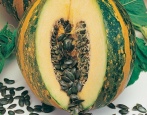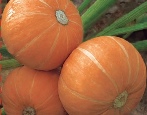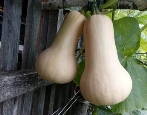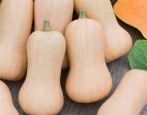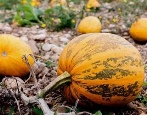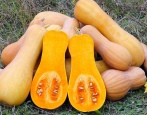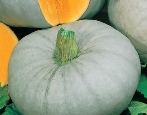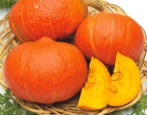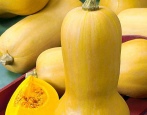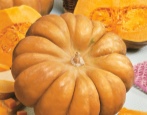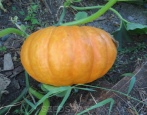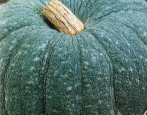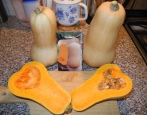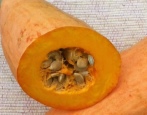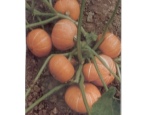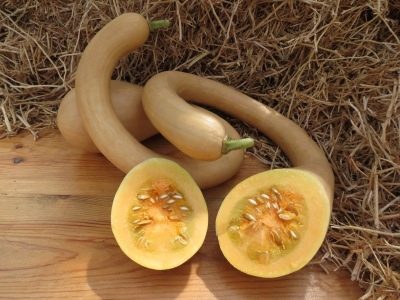
- The form: cylindrical, strongly curved
- Weight, kg: 6-8
- Coloration: orange
- Bark: dense
- Color of the pulp: bright orange
- Pulp (consistency): dense
- Seed nest: small
- Ripening terms: mid-season
- The period from germination to harvest: 110 days
- Appointment: for all types of processing, for home cooking, for making juices
The fruits of this pumpkin variety have such a bizarre shape that they attract the attention of many. They are long and curl like a wind instrument. Hence the name - Trombone.
Breeding history
Trombone is a type of butternut pumpkin. It was bred in Italy. This long and unusual culture in its homeland is called by the affectionate names "zuchetta", "tromboncino" (small trombone), as well as "trumpet from Albenga" (this is a city in Italy). In the same countries where they speak Russian, such a plant is otherwise called spaghetti pumpkin. Despite its southern origin, Trombone is cold-resistant and unpretentious. Today this Italian guest is grown in the middle lane, in the southern regions of Russia, in Siberia, even in the Urals.
Description of the variety
This unique variety of butternut squash not only looks interesting. It's also delicious. Like many other melons, the Trombone pumpkin releases long whips, they spread along the ground. Some summer residents advise to fix them on any support, for example, on a fence, a gazebo wall. In this case, the fruits will not be on the ground, but will hang neatly. It is worth noting that the shoots of Trombone are very powerful, as are the large green leaves growing on succulent petioles.
The bright orange pulp of this vegetable has excellent taste. Moreover, the pumpkin is stored for a long time, more than a year. It is a delicious, unusual, practical variety. In the process of growth, the ovary, when it encounters an obstacle on its way, seeks to bypass it, as a result of which it twists like a snake. When suspended, the pumpkin grows straight down.
The trombone is especially decorative. These unusual vegetables become a true decoration both in the garden and at home. In addition to interesting fruits, it is worth noting the whips: they willingly spread along the ground and with their huge leaves can cover almost everything that the plant will meet on the way. In this way, you can direct the whips to a fence, fence or trellis.
Characteristics of the appearance of plants and fruits
The fruit of the Trombone pumpkin is long, its cylindrical shape is strongly curved, which resembles the wind instrument of the same name. The color of the dense bark is orange, the flesh is bright orange, rather aromatic. The average weight of vegetables is 6-8 kg. There is a small seed nest with few seeds.
Purpose and taste
Absolutely all gardeners and ordinary consumers note that Trombone is a very tasty and sweet pumpkin, one of the sweetest among other varieties. And this is not surprising. After all, nutmeg has a fairly high sugar content. Thus, the culinary uses of this pumpkin variety are virtually limitless. Puddings, all kinds of cakes, candied fruits, and pastries are perfectly made from it. Suitable for absolutely all types of processing, for all home cooking dishes, for making juices, baby food.
It is not always necessary to wait until the vegetable is fully ripe. It is possible to use young fragrant pumpkins, they are prepared directly with the skin instead of courgettes. You can eat this pumpkin fresh, boiled, stewed, baked, make salads with it. It tastes good in any way.
By the way, it is not at all necessary to cut off a huge pumpkin entirely. You can cut off from it just as much as is necessary for the preparation of the dish.The cut will then tighten, and the rest of the vegetable will be stored on the stem and stays fresh longer than in any refrigerator.
Ripening terms
Trombone is a mid-season variety. In order to fully ripen, the nutmeg vegetable will take 110 days. From July to September, you can harvest the ripe crop.
Yield
The yield of the Trombone pumpkin is noted as high, given the size and weight of the vegetables.
Growing and care
The variety will give the highest yield when grown in a seedling way. Although you can plant and seed in open ground. This is especially true in the south.
Growing a long pumpkin requires a soil rich in organic matter. It is advisable to fertilize the soil with humus, as well as ash. Trombone, like other pumpkin varieties, should be planted in a sunny, open area.
Watering is mainly needed only at the beginning of the growing season. When the fruits begin to ripen, it will be enough to water once a week, but abundantly. When most of the vegetables have already formed, it is better to refrain from watering. However, the pumpkin of this variety will not interfere with loosening the soil, and it will also need the formation of lashes.
